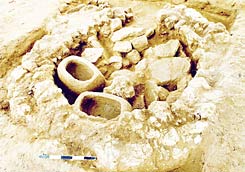A cemetery discovered in the Palmachim area changes the accepted perception of burial customs in the center of the country during the Chalcolithic period

A burial structure discovered in Palmahim, with two glosskamas. Four-five layers of burial structures
Photo: Tsila Shagiv, Antiquities Authority
The more than 50 burial structures that were recently uncovered in the Palmahim area, not far from the mouth of Nahal Sorek, were not supposed to be there at all. The buildings were dated to the Chalcolithic period, and according to all the information collected so far, there was a significant difference between the burial customs of the residents of the center of the country - from the Upper Galilee to the southern coastal plain - and those of the residents of the Shepar regions (the Negev, Sinai and the eastern Transjordan).
The inhabitants of the center of the country at that time, in the fourth millennium BC, buried their dead in natural or hewn caves, where they placed glosskamas (small boxes, about 60 centimeters long, made of clay or stone) with the bones of the dead. The bones were buried in a secondary burial, that is, they were placed in the glosses for a certain period of time after death. Hints and remains of burial structures - round or oval - were found only in the areas of the book.
And yet, in a salvage excavation conducted in the Palmachim sands following infrastructure works for the establishment of a seawater desalination facility, the burial structures were uncovered. It turns out that not only caves were used to bury the dead in the center of the country either. Amir Gorzalzani from the Antiquities Authority, who managed the excavation, says that the buildings were preserved in excellent condition. Some of them were exposed almost entirely, from the foundation to the flattened dome that covered them.
The buildings, some round and some rectangular, are made of local Kurkar stone. They are arranged in straight rows and the spaces between them are paved with small cobblestones, facts that indicate a prior planning of the site. According to the findings, the burial site was active for several generations. Four-five layers of burial structures were uncovered, inside which are glosskamas of various types, the vast majority made of kurkar, as well as tombstones that were integrated into the walls of the buildings. In the rectangular buildings, the tombstones were set in the wall facing the northeast, while in the round buildings, they face the east. From this it can be concluded that the tombstones had some kind of ritual function, although its essence is still unclear.
Other signs of worship are pottery found in niches carved near the tombstones, or in niches built into the wall next to them, in some of the buildings. Signs of a fire were found on the floor of one of the buildings, close to one of the tombstones. Even inside one of the vessels that were removed from the alcoves there were signs of burning. Gorzalzny and his accomplices will try to find out what they burned in it.
It is very difficult to establish the identity of the buried, because very few human bones were found in the excavation, which were not well preserved due to the climatic conditions in the area and especially due to the proximity to the sea. The settlement whose inhabitants were buried in the cemetery has not yet been discovered, but only 500 meters from the cemetery a few years ago a communal burial site of the type typical of the central region was discovered - caves where gloskamas and burial offerings were placed.
The presence of two different cemeteries from the same period in such close proximity raises questions about the interrelationship between them. It is possible that each of them was used by a different population, which differed from its neighbor in social status, ethnicity or cultural affiliation, but any such suggestion is at this point only a hypothesis.
